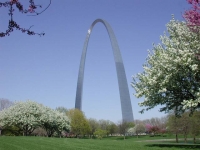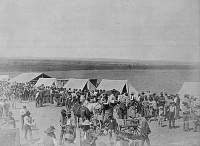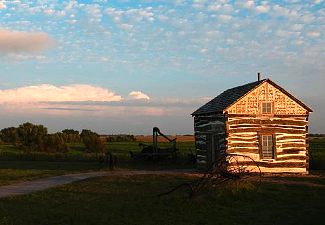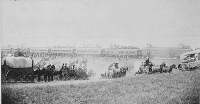
Photo above: The Land Office line at Perry on September 23, 1893. Photo right: View of Oklahoma City in the Indian territories in 1889.

Oklahoma Land Rush
The scene played out across the prairie landscape as homestead families waited for the rush. For those who have seen Far Away, the Ron Howard film of an Irish immigrant and his girlfriend, starring Nicole Kidman and Tom Cruise, it is an unmistakable image. Covered wagons filled to the hilt with supplies, men on horseback waiting to race toward the best plot to stake their flat in one hundred and sixty acres of soil, formerly Indian lands, and claim their spot for the American dream. Of course, for some it was more of a nightmare than a dream in the end, but for many it was just that, the dream of owning a parcel of land in the Oklahoma dust.
Click here to Sponsor the page and how to reserve your ad.
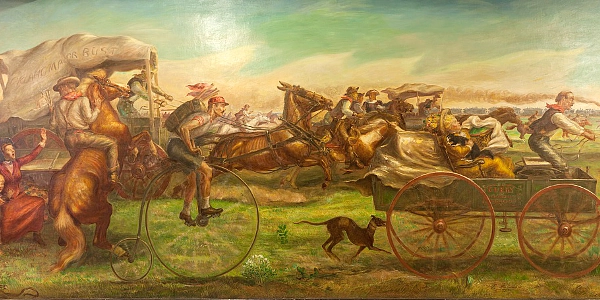
Oklahoma Land Rush Then
The Homestead Act of 1862 had started the process across the western lands. It would, along with expansion of the railroad into the territories over the next forty years, cause a wave of western settlement that would forever change the prairie from the Dakotas to Texas. Two hundred and seventy million acres would be given over to the public from Federal lands, all for only an $18 filing fee. In Oklahoma, white settlers who had been using some of the Indian lands for grazing continued to urge additional settlement rights on this land from the government. These boomers, from C.C. Carpenter to David L. Payne to William C. Couch, finally won these rights when the government bought three million acres of land from the Creek and Seminole, and made one million nine hundred thousand of it open for settlement at noon on April 22, 1889. Boomers waited on the border of the unassigned lands in Kansas border towns such as Arkansas City and Caldwell, at Purcell, Fort Reno, Guthrie, Edmond, Oklahoma City, Verbeck, and Norman. When a pistol shot signalled the opening, fifty thousand people began a frantic race. Some had jumped the gun, however, leading to the Oklahoma term, Sooner. One month later, the Indian Territories had become the Territory of Oklahoma through a decree of Congress.
Four years later, on September 16, 1893, the largest land rush opening occurred on the Cherokee Outlet in north central Oklahoma and the Tonkawa and Pawnee reservations, with more than 50,000 people claiming six million five hundred thousand acres.
Oklahoma City - By the end of the first day of the Oklahoma Land Rush of 1889, it had grown to more than 10,000 people. Orlando, Oklahoma Territory - Thirty-six thousand people registered for land at Orlando, Oklahoma Territory on September 15, 1893. Additional lands were opened up in Oklahoma through the Homestead Act after the final land rush of 1895. These lands were determined by lottery. August 1, 1901, the Wichita-Caddo, Comanche, Kiowa, and Apache lands were the last large land opening in the state.
Photo above: Painting at the Department of Interior by John Steuart Curry, 1939, "The Oklahoma Land Rush, April 22, 1889." Photo taken by Carol M. Highsmith, 2011. Courtesy Photographs in the Carol M. Highsmith Archives, Library of Congress. Below: One of the period buildings at Homestead, the Freeman School. Courtesy National Park Service.

Oklahoma Land Rush Now
How it affected the Cities? This was certainly a boom or bust time, for individuals looking for land to find their fortune, as well as for towns looking to become cities and wanting to make a name for themselves. Some became well-known and prosperous such as Oklahoma City over the next hundred years; others hit their zenith on land rush day.
Oklahoma City - Capitol of the state and home to almost 500,000 people.
Orlando - Around 200 people call Orlando home, a good deal fewer than the 36,000 that showed up on September 15, 1893.
Land Rush and Homestead History Sites Today
There is not a single comprehensive site that tells the story of westward expansion, the Oklahoma Land Rush, or the Homestead Experience, but a myriad of historic sites dotting the landscape and trails of Oklahoma, Nebraska, Kansas, and beyond.
Oklahoma History Center, Oklahoma City, Oklahoma
Break O'Day Farm and Metcalfe Museum, Durham, Oklahoma
Canadian County Museum and Fort Reno, El Reno, Oklahoma
Museum of the Western Prairie, Altus, Oklahoma
Stuhr Museum of the Prairie Pioneer, Grand Island, Nebraska
Homestead National Monument of America, Beatrice, Nebraska
T-Shirts and Souvenirs

Oklahoma Land Rush T-Shirts and Souvenirs. Great for pioneer and western history fans.
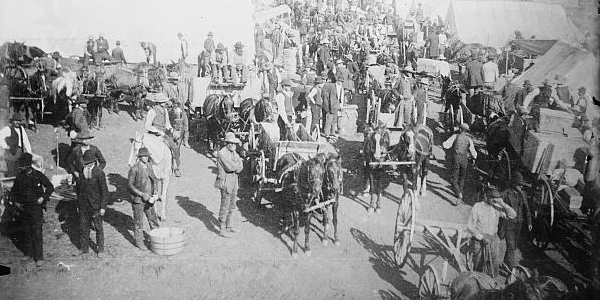
Oklahoma Land Rush
Things You Should Not Miss
1. The Oklahoma History Center. This museum coves the breadth of Oklahoma history on eighteen acres, with an 215,000 square foot learning center. It is located across from the Governor's mansion.
2. Fort Reno and the Canadian County Museum. Fort Reno was established in 1874 to stem the Indian problems and played a role in the Land Rush proceedings by protecting the order of the rush. Both the fort and museum contain a number of historic buildings and exhibits.
3. Homestead National Monument. No, it's not in Oklahoma, but it covers the topic of homesteading, pioneers, and land rushes with exhibits and period buildings.
Photo above: Oklahoma Land Rush, date unknown, Bain News Service. Courtesy Library of Congress.
Dates of the Oklahoma Land Rush
April 22, 1889 - Creek and Seminole Lands
September 22, 1891 - Iowa, Sac, Fox, Pottawatomie, and Shanee Lands
April 19, 1892 - Cheyenne and Arapaho Lands
September 16, 1893 - Cherokee Outlet
May 3, 1895 - Kickapoo Lands
Visitor FAQ
